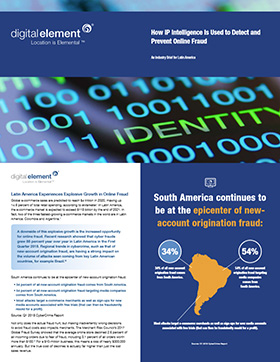In Latin America, the e-commerce market is experiencing dramatic growth. In fact, two of the three fastest-growing e-commerce markets in the world are in Latin America: Colombia and Argentina.A downside of this explosive growth is the increased opportunity for online fraud. Recent research showed that cyber frauds grew 88 percent year over year in Latin America in the First Quarter 2018. Regional trends in cybercrime, such as that of new-account origination fraud, are having a strong impact on the volume of attacks seen coming from key Latin American countries, for example Brazil.
South America continues to be at the epicenter of new-account origination fraud:
- 34 percent of all new-account origination fraud comes from South America.
- 54 percent of all new-account origination fraud targeting media companies comes from South America.
- Most attacks target e-commerce merchants as well as sign-ups for new media accounts associated with free trials (that can then be fraudulently resold for a profit).
Source: Q1 2018 Cybercrime Report
Not only does the actual fraud hurt, but making inadvertently wrong decisions to avoid fraud costs also impacts merchants. The Merchant Risk Council’s 2017 Global Fraud Survey showed that the average online store declined 2.6 percent of all incoming orders due to fear of fraud, including 3.1 percent of all orders worth more than $100. For a $10-million business, this means a loss of nearly $300,000 annually. But the true cost of declines is actually far higher than just the lost sales revenue.
Online retailers in Latin America are definitely paying a price in turning away more legitimate customers and manually reviewing more orders:
- 82 percent of merchants conduct manual reviews.
- 9.2 percent of orders are rejected due to suspicion of fraud.
- 57 percent of orders are accepted post review.
- 1.7 percent of sales become chargebacks.
Source: 2017 Online Fraud Report for Latin America
These are substantial numbers, yet careful management of the authentication process and deployment of the right tools can yield significant results in terms of online fraud reduction.
The most effective fraud prevention involves multiple technology solutions that work in tandem to identify who real customers are and how they perform activities and transactions online. Accurately recognizing a user’s digital identity can be based on a variety of data parameters (i.e. location, device type, etc.) and combined with behavioral analytics to help merchants more successfully distinguish between legitimate consumers and potential fraudsters, blocking high-risk activities in real time.
See all this and more by viewing the full whitepaper here:
